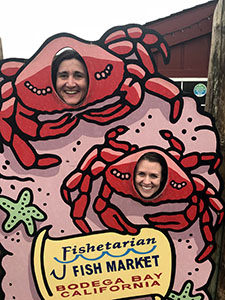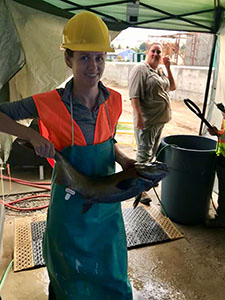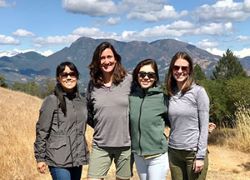Whitney at the San Joaquin River by the Friant Dam during a visit with CDFW staff.

Whitney and Christina Sloop during a visit to the Bodega Bay Marine Laboratory.

Whitney learning about the Central Valley spring-run Chinook salmon spawning process at the San Joaquin Hatchery.

Whitney with fellow members of the Science Institute team during a strategic planning retreat at Pepperwood Preserve.
Whitney Albright is CDFW’s Climate Change Specialist and member of the department’s Science Institute. Growing up in Houston, where severe storms and hurricanes are common, she had an early fascination with weather. That led to a degree in Meteorology from the University of Oklahoma where she was able to take advantage of world-class weather technology and research.
Whitney changed tracks slightly for grad school and studied forestry at the University of Washington, though still with an interest in climate and weather, focusing on the impacts of climate change on trees in the Pacific Northwest. Soon after earning her master’s degree, she saw a job announcement for a climate position with CDFW, and it was a perfect fit. She has been in her current position, based in the Sacramento headquarters since 2013.
What exactly is your role as Climate Change Specialist?
As Climate Change Specialist, I help identify climate change-related risks to the department’s mission and the resources that we manage, and develop strategies, initiatives and projects that will address and minimize those risks going forward. Much of what I do internally is look for opportunities to address climate risks within our various programs and activities and increase cross-program communication about climate change. I also develop and disseminate materials to support and empower staff to incorporate climate science and adaptation strategies into their work, as appropriate.
Another part of my job is working externally with partners. California has many different statewide climate change initiatives which involve various departments and agencies helping inform strategy or action plans. I work alongside other CDFW staff to make sure biodiversity-related issues are well represented in these different venues. One example is the Safeguarding California Plan, our state climate change adaptation strategy, which includes climate adaptation goals and strategies for biodiversity and habitat, among many other sectors. CDFW is responsible for setting these goals every few years, working alongside other agencies.
What is the Science Institute and what is your role in that?
The CDFW Science Institute’s mission is to advance scientific capacity, excellence, integrity, quality, diversity and transparency in support of CDFW’s mission-related decisions, initiatives and programs. This means that our Science Institute team helps elevate our science at the department, support the transparency of that science and our scientists’ efforts, communicate what we are doing both among our own scientific community and externally, and ultimately make sure that the science is usable and is informing our management decisions. Within the Science Institute we have an emphasis on providing scientific support and helping advance biodiversity conservation, climate change resilience and the implementation and update of the State Wildlife Action Plan, a statewide planning tool that guides conservation efforts and brings in a federal funding stream in support. Since these are such cross-cutting issues, spanning across programs and geographical boundaries, our team members coordinate on different projects and work with many scientists throughout the department.
Are you working on any collaborative projects right now?
The Science Institute has created a series of focus teams, or SIFTs (Science Institute Focus Team), which are workgroups that focus on various topics relevant to the department, such as habitat connectivity, scientific literature access, effective use of drones in science, science communication and more. I have the pleasure of leading the Climate Change SIFT, which is a collaborative team of dedicated staff from across the state who are informing the climate science program from their various perspectives on pertinent issues to climate adaptation and resilience. Our mission is to figure out how we can more systematically support staff in their efforts to integrate climate change into their work throughout the department.
One project the Climate Change SIFT worked on this past year was to develop a climate change survey for department staff to gauge their understanding of climate science and adaptation options and better recognize their needs for climate-related data and guidance. The results have been very illuminating and will help inform what we do and what our climate change-related priorities are. For example, we found that many people want access to climate-related trainings, workshops and educational materials. Another recurring theme is people seeking guidance on how to address climate change in CEQA review, comment letters and in the context of permitting. Now that these issues have been identified and emphasized, we will work to come up with tools and information to help.
Any other projects you are working on?
One ongoing project I am very excited about is the establishment of a new network of weather stations on department lands and tidal gauges along the coast. We have been identifying what equipment is needed and where we can place each station. The goal is to build a permanent statewide climate monitoring network coupled with ecological monitoring to help us measure long-term changes in climate on our own lands and waters and identify influences or trends of a changing climate on our lands and, more generally, the state’s biodiversity. These weather stations and tidal gauges are part of a growing public-private partnership under the California Biodiversity Network’s expanding sentinel site system. As part of this partnership, all partners’ data will be jointly managed by UC Berkeley and made available to the public. This project has been fun, propelling me back to where I began, back to meteorological measurements and instrumentation and figuring out how to use that in the context of the department’s mission.
You must deal with a very wide breadth of subject matters. Is there a certain area or topic you enjoy most?
I suppose I have a bit of a soft spot for forestry because that was my background, and it is easier for me to understand the issues affecting forests. One of the things I like most about my job is how varied it is. The department’s work covers so many different issues, and I am continuously learning about everything we do and how climate change is related. On top of that, climate change itself is such a far-reaching issue, touching every habitat type and species. I constantly need to stay on top of the current science and research, which can be fascinating even if somewhat challenging at times!
What are some of your biggest concerns regarding climate change?
The number and intensity of extreme climate events in the last few years, such as drought and wildfire, have brought the urgency of how we respond to the forefront. It is getting harder and harder to ignore climate change in California, particularly the impacts to our beautiful landscapes, biodiverse ecosystems and species, but also our food and water security. These extreme events are projected to become even more frequent and/or intense in the future. They are concerning when viewed as isolated events, but when they start to accumulate and compound it is even harder to find solutions for resilience and recovery. One of the biggest things we are working on is utilizing science to better understand the frequency, size and cumulative effect of these events and find ways to address them.
Would you say you are optimistic or pessimistic going forward?
I am optimistic because we have staff that are so passionate and good at their job. It is easy to be reactive to events and a lot harder to be proactive, but I think there is the will and the expertise in this department to be proactive. It is incredibly rewarding to be working with people who are so dedicated and who want to act on climate change.
Leadership support also makes a difference and is particularly important at the federal, state agency and department levels. We need support from the top to meet this huge challenge that affects everything we do, especially in the long-term. In that respect, the stars have aligned in that there are motivators and motivation to work on addressing this critical issue.
Is there anything specific you want to see happen in the future?
The direction outlined in the Science Institute’s 2021-26 Strategic Action Plan (SISAP) is to work toward climate change being directly integrated into more and more programs and department guidance or policy. This would make it more ingrained and something we inherently consider everywhere it applies. Currently, there is no departmentwide policy on climate change. This is something that we will be working on soon as outlined in the SISAP. We will also be developing and implementing a CDFW biodiversity and climate change response strategy. I am very excited to work on these things, since I think these processes and documents will set a solid foundation from which our staff and others can work to create a more climate-resilient California.
What resources are out there for people to learn more?
There are many resources online. For instance, the South-Central Climate Adaptation Science Center and the University of Oklahoma collaborated on a series of climate change videos available on YouTube which our Office of Training and Development has also made available in LEARN for CDFW employees. The series is made up of short introductory videos that cover everything from how earth’s energy budget works to how climate can be impacted by greenhouse gases, how climate projections are developed, as well as what climate change means for communities, ecosystems, species, etc. It is a cool way to understand the basics of climate change science and its impact across the globe.
CDFW Photos